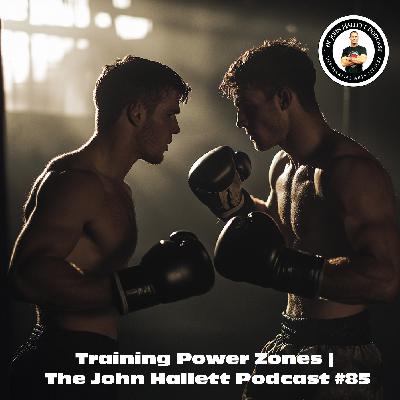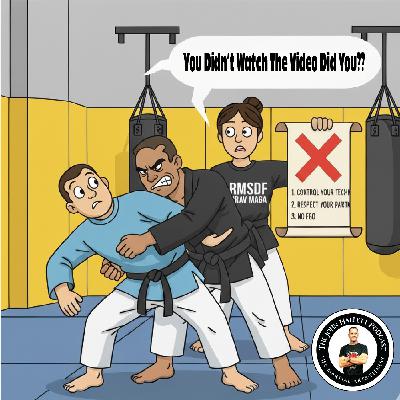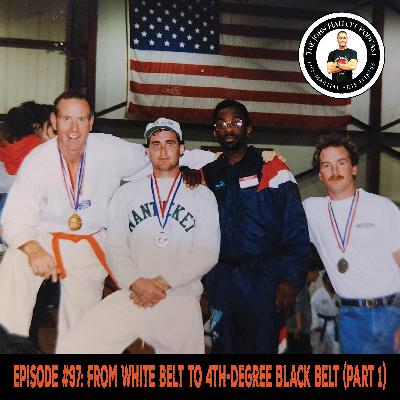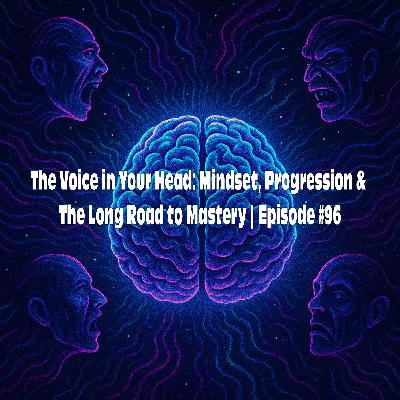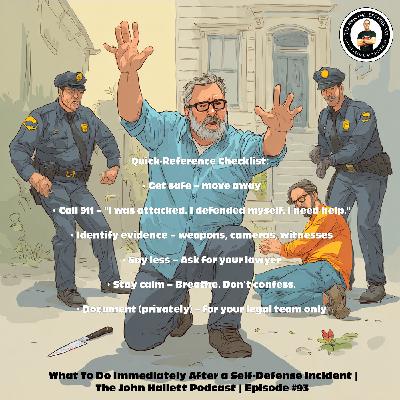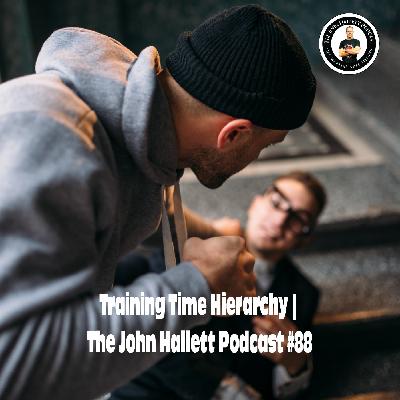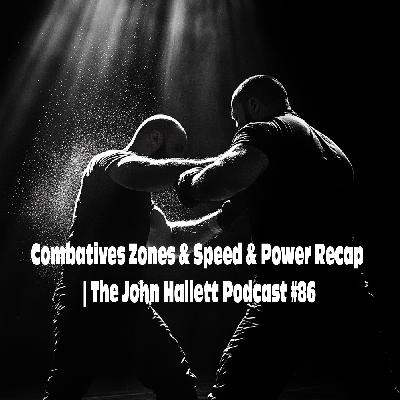Training Power Zones | The John Hallett Podcast #85
Description
Hey, everybody, let's see if we can get this one done without Josh. He is training in Minnesota with Nick doing another level of citizen defender. One might ask, why am I not there? They're doing the last level that Bill and I did, so they're getting it done. Good luck to those guys. I guess Josh already got need in the head in a drill by the one and only. All right, Minnesota Martial Arts. Now I'm gonna black on blank on his name. That is terrible. Oh, well, Greg Nelson. I had Todd Fosse, that's the instructor for ids, so mixed up those names. So I was gonna bring on Leo, my French bulldog, but he decided to work in the office with my wife. He's more popular today. He usually joins me in the afternoon, but he must be boycotting me. He is much better looking than Josh, but, you know, some people might argue. So today we're talking about training power zones. These are really important, guys. I'll bring up the slide from our Clear Sky Dot training. Oh, where is it? There it is. Website where you can train with us online. That's great for our students. You know, get on there, get in it. There's a ton of stuff, including testing for each belt level that is required here at Rocky Mountain Self Defense and Fitness, our home base here in Castle Rock, Colorado. So look, guys, I remember being a white belt and kind of my instructor calling me the wild and crazy one, the one and only Master Miller from Nantucket Taekwondo. He was always telling me to slow down. I had just came off high school football, and I just knew one thing like, go hard, go 100%. And that leads to injuries and a whole ton of other things that can happen in that 100% all out. And I'm constantly telling beginners, slow it down, slow it down. And you know what I see? Looks like I was going slow and. And you're all going. Or we are all going way faster than we think. You know, standing off to the sidelines, you start to see it. And you know, one thing I tell people, I've watched you hit the bag at 100%. You're pretty darn close to that in that drill or whatever we might have been doing. So to quickly summarize, zone one is zero to 20. Zone two is 20 to 40% speed and power. So zone three, 40 to 60. Zone four, controlled speed and power. And zone five, 80 to 100. And we're leaving that to testing. You know, once in a while type of training where you can get hurt, but we need to do that. Sometimes test our mental toughness and put us under that real world stress. But the likelihood of getting hurt, injured on those always goes up. So we don't want to spend much time in zone five at all. Now look, zone one, it's on the slide a bit here, but I'm looking on my bigger screen because of my old eyes. Slow is smooth. You know, if you learn slow, you can get this stuff down. You know, focus on precision, timing, the mechanics. You're really going way slower than you think you should. There's really no power behind everything you do, you know, we'll call it slow touch sparring. When we're doing sparring at this level, it's just slow. It's just landing the light touch. Just. You're not even going to knock over that glass of water. I always kind of joke around and say, you know, unless you have a sippy cup at the dinner table, you know, you should be able to reach out and touch somebody without smashing them. You know, you want to build clean habits and good muscle memory here. You want to learn more on quote unquote muscle memory? Check out Andrew Huberman's podcast. That's fantastic. Neuro guy. I forget his whole repertoire. But we were not going to get into Andrew Huberman. So, you know, the philosophy here is slow is smooth and smooth is fast. One of my first levels, I can't remember the first or second. And I had a guy that I was training with in the hotel after, and he said to me after the test, wow, I kind of thought you were really slow and wonky, some things of that effect. And, and I said, you know, why'd you think that? Oh, when we were training, you just did. Everything was really slow. Like I'm just trying to get it down so when I do go fast, the wheels aren't falling off. You're building good habits. It pays off in the long run. You know, zone two, where, you know, we're moving up a little bit, 20 to 40%. But it is still pretty darn slow here, guys. 20 to 40%. Not that fast at all. Want our reactions to become natural in these. Sorry to click the slide. For those of you guys on YouTube, you can check these slides out without even visiting our portal or signing up for a low cost membership on there. All this stuff takes time and until I hit Powerball, I'm trying to make some money. All right, let's see. Focus, flow control, consistent technique. Being able to do it time after time without your, let's say uppercut, you know, breaking 90 degrees being too far away from the person. We're doing this in self defense. You know, you're building those good habits that I'm using this tool. It's slow enough to recognize. I have an uppercut, elbow, I have whatever technique, a knee strike. Hey, they're a little bit further away. I need to go to a kick or they're further away. I need to go to an advancing kick pick to keep my tools on this guy and to stay engaged, right? Power is really low to moderate. It's not gonna cause bruising. Most people aren't going to say ouch when you hit him at 20%. You know, you get up to 40, you know, depending on somebody, but it starts to get you accustomed to getting hit. We even say with our kick shields, you're getting used to getting hit. So this is not a big shot shock in an actual fight. And a lot of people fool themselves and think they're going to be fine. And then there's utter shock on their face when they actually get hit. Even remote, even at 50%, never mind somebody hitting you at full speed. So we want to kind of get used to getting hit and sparring and all that type of stuff at this 20 to 40 zone, get comfortable with it. You know, it doesn't happen overnight. We want to be able to groove in the movements. You know, safe repetition builds confidence. You know, you're not. Your partner's not freaking out and doing weird things on you because you're just going so fast and out of control and they're just trying to stay the heck away from you. We want to spend most of our training time in zone one and two. That's 60%. You know, if you kind of do the math on those, we're in there. It's a good, good zones to be in. My favorite two zones, constantly saying, if you don't see the fight slow, you're not seeing it fast. You're just fooling yourself. You're just windmilling in, you're just spazzing out. You know, hey, when in doubt, be aggressive, spaz out. You know, by all means, windmill in. But man, I don't want to have to resort to those type of things. Zone 3 is at 40 to 60%. Smooth is fast, right? Focus on realism without recklessness. Again, nobody wants to be your partner when you're crazy. Speed's moderate. Our power is controlled and clean. You're able to stop that punch. You're going slow enough that you can stop the strike. You know, your partner maybe moves a little bit under Unexpectedly, you're still able to control that. And that's a thing that takes time. It's repetition, like everything else. Repetition, purpose, add pressure while still staying sharp. You know, we're going to spend about 20% of our training time on this. And one note on all of these. You know, they're great to do on a heavy bag. You know, when you're kicking a kick shield, you can practice these things, shadow boxing without a partner and kind of feel your own speeds and try to figure that out. And, you know, when in doubt, video yourself. Be your own coach. You know, watch yourself, try, like full speed and then go, all right, let me cut that down in half and really try to relate that. It's a tough thing to do. It's a tough thing to even watch and kind of tell, but you just have to do it. It's a tougher things for coaches. You know, figuring out people and, you know, their different speeds and knowing, you know, hey, that guy is actually extremely fast. I think of coach Ben. He's extreme explosive and fast, more so than the average person. So watching different people, it's always a challenge for coaches to, you know, help that person along their journey. This 60 to 80, I guess that's where I'm at. Timing under pressure. Zone four is where we're at. Sorry, I need Josh. Timing under pressure, speed. You know, you're going fast here. Power's high, but with restraint, you know, you're still able to pull it off even if you're hitting them pretty hard. You were. You were dialing it back. That happens to me, you know, quite a bit at this speed that, you know, something happens whether, you know, you get away from yourself a little bit. You know, a lot of times a person moves, you're still able to pull the brakes. Even though you probably hit that person at 50%. But you were, you know, you dialed the back 25%. It's a tough thing to do and recognize in fighting. You know, I want to find my cracks in my technique. You know, the wheel, you know, things start, you know, coming off, coming unhinged. The wheels are coming off the car at this, and you really start to recognize, I should be spending some more time in zone one or two, possibly to kind of fix those errors that were happening under that type of speed and stress, you know, 15% of the time. Zone five. All right, 80 to 100. That's a stress test. What are you doing? It's probably in an advanced test is where we're going to see this. And I actually Just updated these slides here on some of this. I guess I added it on mine, but not on yours because we've got takeaways coming up next. But, you know, you're going max speed and max power, you know, simulates a real fight stress. But we're rarely doing this right because of that high risk of injury, you know, a concussion, all that type of stuff, or training this fast. We don't want to do it that much, but we have to do it sometimes. I'll use the NF

